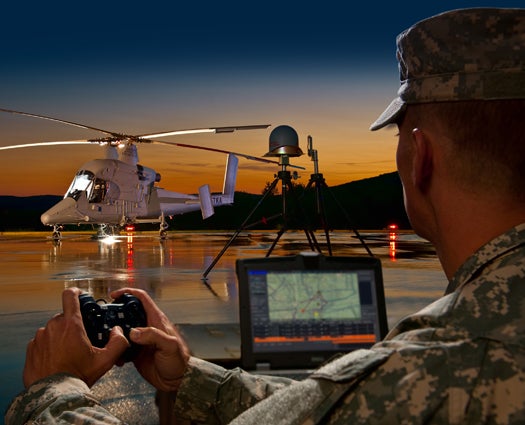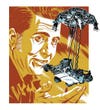From pilotless cargo copters to air pressure suits that can fly from the edge of space, these innovations represent the year’s most important achievements in aerospace technology. See all 10 of them here.
Click here to enter the gallery
Grand Award Winner: Lockheed Martin/Kaman K-Max
Since 2008, roadside bombs and other IEDs have accounted for the deaths of more than half the U.S. soldiers killed in Afghanistan. Moving cargo in large convoys put many of those soldiers at risk. The Kaman K-Max autonomous helicopter removes the people from those supply lines. The pilotless copter can haul 6,000 pounds up to 250 miles, with its load suspended from a 75-foot tether. The only human intervention comes when a Marine with a laptop and an Xbox-like controller presses the start button; after that, K-Max’s autonomous flight controls take over, using data collected by onboard altitude and orientation sensors to fly along preprogrammed GPS routes, day or night. Since last December, the two pilotless K-Max choppers deployed in Afghanistan have carried more than 2 million pounds of cargo. Range: 250 miles Cargo Capacity: 6,000 pounds Top Speed: 100 knots (115 mph)
Red Bull Stratos Pressure Suit
What do you wear to dive from the edge of space? Four years ago, daredevil Felix Baumgartner put that question to designers at the David Clark Company, which made the pressure suits worn by the U.S. Air Force’s high-altitude U-2 pilots. The designers responded by building the most advanced pressure suit ever created, with a powered heating system, a stable aerodynamic profile, and a face mask embedded with heated wires to prevent freezing in the -70°F air. On October 14, Baumgartner put on his suit and rode a helium balloon to an altitude of 128,100 feet. With millions watching on television and YouTube, he jumped, reaching a top speed of 833.9 mph (Mach 1.24) before deploying his chute and landing safely in the New Mexico desert.
NASA Gravity Recovery And Interior Laboratory
On New Year’s Day, two probes joined each other in lunar orbit to begin creating the most detailed map of the moon yet. As NASA’s twin GRAIL satellites, named Ebb and Flow, fly in formation over mountains, craters, and underground geological formations, the moon’s gravity will fluctuate in strength, changing the distance between the two craft. By measuring these fluctuations, GRAIL will produce an ultra-high-resolution map of the moon’s gravitational field.
Boeing PhantomEye
With its inaugural test flight this year, Boeing’s Phantom Eye surveillance drone proved that hydrogen could power aircraft capable of extremely long flight times. Phantom Eye’s engineers modified its two Ford internal combustion engines to burn liquid hydrogen, which has a much higher energy-to-weight ratio than fossil fuels. When testing and development is complete, 1,900 pounds of liquid hydrogen should keep the propeller-driven Phantom Eye at 65,000 feet for up to four days—three times as long as its closest competitor.
University Of Pennsylvania Nano Quadrotor Robots
The University of Pennsylvania’s GRASP (General Robotics, Automation, Sensing, and Perception) lab has developed autonomous airborne ‘bots that can work together to do tasks like map unfamiliar spaces and perform search and rescue. This year, two GRASP students launched the company KMel Robotics to push swarming robots toward commercialization.
Solazyme Solajet
Last November, a United Airlines 737 made the first U.S. commercial flight running on a biofuel blend, a 60:40 mix of conventional jet fuel and Solajet. Solazyme, a California startup, makes Solajet by feeding biomass sugars to genetically modified microbial algae. United has since agreed to purchase 20 million gallons of Solajet a year starting in 2014—a significant step toward biofuel adoption in the airline industry.
NASA Jet Propulsion Laboratory Asteroid Anchors
A team led by engineer Aaron Parness at NASA’s Jet Propulsion Laboratory has solved one of the biggest challenges for future space expeditions: How to attach to a zero-gravity surface without drilling permanent anchors. Parness developed a set of robotic feet that grab uneven, rocky surfaces using hundreds of tiny hooks known as microspines. Modeled after the grasping spines on cockroach legs, the polyurethane microspines grip tightly yet can quickly release when it’s time to move to a new target.
Northrup Grumman Long-Endurance Multi-Intelligence Vehicle
The Army’s Long-Endurance Multi-Intelligence Vehicle (LEMV) is the U.S. military’s first successful hybrid airship. Helium-filled nylon balloons give the LEMV the ultra-long flight time of a blimp. But its aerodynamic hull, fixed wings, and vectored-thrust engines provide additional lift and maneuverability, allowing it to take off with heavier payloads, stay in the air longer, and land safely at the end of the mission without taking on ballast to compensate for burned fuel. The football-field-size, pilot-optional airship, scheduled to go to Afghanistan next year, provides an unrivaled 21 days of “unblinking stare” surveillance from an altitude of 20,000 feet.
NASA PhoneSat
Scientists at NASA’s Ames Research Center have built the most affordable satellite to date, a $3,500 device the size of a coffee cup that uses an off-the-shelf HTC Nexus One smartphone as a central processor. (A cheap off-the-shelf radio antenna handles communication with the ground.) PhoneSat 1.0, scheduled to launch by the end of this year, will beam back photos of Earth on an amateur radio band for 10 days, or until the battery dies. Subsequent iterations will be capable of much more: PhoneSat 2.0 will have a two-way S-band radio antenna (which most satellites use to communicate with the ground) and solar panels for extended power.
Mars Curiosity Sky Crane
Most previous Mars landers used airbag cushions to prevent damage during touch-down. The Curiosity rover was too heavy for airbags, so a team at the Jet Propulsion Laboratory created the sky crane. On August 5, the crane successfully lowered Curiosity 65 feet, using three nylon tethers, from a thruster-powered platform to the Martian surface. NASA may well turn to the system, which is scalable for different crafts, on future missions to Mars.










